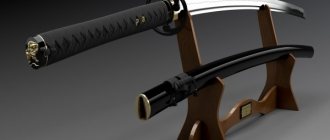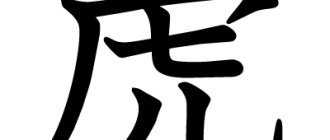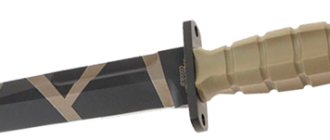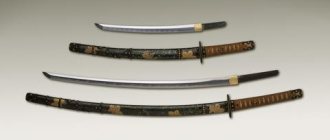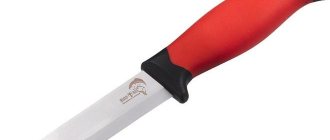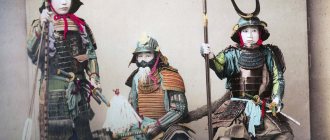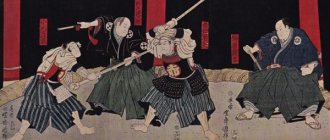Katana is the Japanese term for broadsword. Often referred to as the post-Muromachi Period uchigatana sword, which is a type of Japanese sword also commonly known as a "samurai sword", and generally defined as a standard-sized, moderately curved Japanese sword (as opposed to the older Japanese sword “tachi” (tachi), which has a greater bend) with a blade more than 60 cm long.
The katana has a characteristic appearance: a curved, thin, single-edged blade, a round or square guard, and a long handle adapted for a two-handed grip. The katana is historically associated with the samurai in feudal Japan, and is known for its sharpness and cutting abilities.
Origin of the term "katana"
Strictly speaking, the term "katana" in Japanese applies to any type of single-edged sword, of any origin, not just Japanese.
The term "katana" was originally used as a general term for single-edged swords that have a curved blade. While the "sugata" (shape) could be various, including double-edged, the term is now incorrectly used to describe a "nihonto" (Japanese sword) 2 "shaku" (606 mm) long and longer, also known as "dai" or " daito."
This feature distinguishes the katana from the straight sword "chokuto", which came to Japan from China through Korea. The Chokuto was supposedly the first katana-shaped sword, which was modeled after swords imported from Korea. This appearance of the first nihonto (Japanese sword) occurred during the early period of Japanese feudalism and the emergence of the daimyo class in the late 9th century.
Pronounced "kah-ta-han" (Japanese), the kanji character originally denoted a dao sword, or saber, or sword in China, after which the word was borrowed into Portuguese. In Portuguese, the meaning of the word "katana" was "large knife". Since Japanese does not have separate plural and singular forms, both the terms "katana" and "katana" are correct.
Another term, daikatana, is a pseudo-Japanese word for "big sword", derived from a misreading of a kanji word (Japanese "daito"), derived from the Chinese dadao (a variation of the dao sword). The reading error occurred because kanji can be read in different ways depending on their combination or multiple words in a phrase. The term has been used in some works of fiction to describe a large katana; the video game Daikatana uses this pseudo-term in its title. The correct name for this type of weapon is tachi, otachi and nodachi.
Meitou is a rare class of katanas. The term "Meitou" means "famous sword" or "name sword". These were very valuable swords, passed down through generations, won in battle, or given as a sign of respect. Meitou is superior to a regular katana in almost every aspect: cutting ability, wear resistance, etc. Meitou were very expensive due to their quality; these katanas were handcrafted by a famous blacksmith, and received their name through battle and through their long existence, and sometimes even through royalty.
Education and code of the samurai
When raising future samurai, they tried to instill in them indifference to death, physical pain and fear, a cult of respect for elders and loyalty to their master. The mentor and family primarily focused on developing the character of the young man who took this path, developing in him courage, endurance and patience. Character was developed by reading stories about the exploits of heroes who glorified themselves as samurai of the past, and by watching relevant theatrical productions.
Sometimes the father ordered the future warrior, in order to become bolder, to go alone to a cemetery or other “bad” place. It was common practice for teenagers to attend public executions, and they were also sent to examine the bodies and heads of dead criminals. Moreover, the young man, the future samurai, was obliged to leave a special sign that would prove that he was not shirking, but was actually here. Often, future samurai were forced to do hard work, spend sleepless nights, walk barefoot in winter, etc.
Training of the future samurai (still from the 2003 film “The Last Samurai”)
It is known for certain that samurai were not only fearless, but also very educated people. The Code of Bushido, which was already mentioned above, stated that a warrior must improve himself by any means. And therefore, the samurai did not shy away from poetry, painting and ikebana, they studied mathematics, calligraphy, and held tea ceremonies.
Zen Buddhism also had a huge influence on the samurai class. It came from China and spread throughout Japan at the end of the 12th century. Samurai found Zen Buddhism as a religious movement very attractive, as it contributed to the development of self-control, will and composure. In any situation, without unnecessary thoughts or doubts, the samurai had to go straight to the enemy, without looking back or to the side, in order to destroy him.
Many samurai actively used Buddhist meditation practices
Another interesting fact: according to Bushido, the samurai was obliged to carry out the orders of his master unquestioningly. And even if he ordered to commit suicide or go with a detachment of ten people against an army of a thousand, this had to be carried out. By the way, the feudal lords sometimes gave the order to the samurai to go to certain death, to battle with an enemy superior in numbers, just to get rid of him. But one should not think that samurai never passed from master to master. This often happened during skirmishes between small feudal lords.
The worst thing for a samurai was to lose honor and cover himself with shame in battle. They said about such people that they were not even worthy of death. Such a warrior wandered around the country and tried to earn money like an ordinary mercenary. Their services were used in Japan, but they were treated with disdain.
One of the most shocking things associated with samurai is the ritual of hara-kiri or seppuku. A samurai had to commit suicide if he was unable to follow Bushido or was captured by his enemies. And the ritual of seppuku was considered an honorable way to die. It is interesting that the components of this ritual were a ceremonial bath, a meal with the most favorite food, and the writing of the last poem - tank. And next to the samurai performing the ritual, there was always a faithful comrade, who at a certain moment had to cut off his head in order to stop the torment.
Story
The katana appeared as an alternative to the tachi with a straighter blade. Its roots go back to at least the Kamakura Period - there are blades dating from that era in various national repositories in Japan.
The rise in popularity of katanas is believed to have been associated with changes in the nature of hand-to-hand combat. The quick draw of the sword was well suited for those battles where victory depended on quick reaction. The katana was well suited for these purposes, being worn behind a belt-like sash ("obi") with the blade pointing upward. Ideally, a samurai could draw a sword and strike an opponent in one coherent movement. Previously, the curved tachi was worn with the blade down and suspended from a belt.
The length of the katana blade has varied significantly throughout its history. At the end of the 14th and beginning of the 15th century, the length of the katana blade varied from 70 to 73 cm. During the beginning of the 16th century, the average blade length was about 60 cm. At the end of the 16th century, the average blade length was already about 73 cm.
The katana was often paired with a similar smaller secondary sword known as a wakizashi, or shoto (essentially a short sword). She could also carry a tanto (samurai dagger), an even smaller sword with a knife-like shape. The katana and wakizashi together were called daisho and demonstrated the social status and personal honor of the samurai.
Katana Proficiency
A katana is a cutting weapon that can decapitate an enemy with one blow. The main technique of wielding a Japanese sword is that the blow is struck not at a right angle, but along a plane. Also, to simplify the application of cutting blows, the center of gravity was located closer to the blade.
The length of the katana allowed for various maneuvers. You need to hold it with both hands at once. The middle of the left palm was located at the end of the handle, and the second hand squeezed the area near the guard. Participation in the swing of two arms at once made it possible to obtain a greater amplitude, which strengthened the blow.
There are three types of stances for katana fencing:
- Jodan - the sword is on the top level
- Chudan - in this position the sword should be in front of you
- Gedan - the sword is on the lower level
To successfully apply the mastered fundamentals of katana fencing, you need to be able to anticipate all the enemy’s movements and accurately plan your actions in a short time.
Traditionally, Japanese sword fencing training is divided into three levels:
- Omote is an open level, it does not delve into “hidden” sword techniques
- Chudan - intermediate level
- Okuden - closed level
In Japan, many traditional schools teaching the art of swordsmanship have survived to this day. These schools were able to continue to exist even after the ban on wearing swords, which was established by Emperor Meiji.
Design
A genuine Japanese sword is made from a specialized Japanese steel called Tamahagane, consisting of a combination of hard high-carbon steel and tough low-carbon steel. Each of these types of steel has its own advantages and disadvantages. High carbon steel is harder and holds an edge better than low carbon steel, but it is also more brittle and can break in combat. Having a small amount of carbon allows the steel to be more malleable, giving the steel the ability to absorb impact energy without breaking but becoming dull with use. Katana manufacturers take advantage of the strengths of both types of steel. This is achieved in many ways, the most common being by making a high carbon steel U-shaped part (the outer blade), and placing a low carbon steel core inside the U-shaped notch, and then heating and hammering the entire structure into a single piece. Some gunsmiths use four different pieces (core, blade, and two side pieces), some even use five pieces.
This assembled blank is heated and forged for several days, then the blank is folded in half and forged again to remove impurities from it. Basically, the katana blade blank is folded no more than 16 times, after which it is forged into the shape of the blade. At this stage, the workpiece is only slightly curved, or not curved at all. The katana receives a slight bend during the process of hardening the blade; the blacksmith covers the blade with several layers of wet clay solution, the recipe of which is different for each katana manufacturer, but mainly consists of clay, water, sometimes ash, powdered stones, and sometimes rust. The blade of the sword is coated with a thinner layer than the sides and back of the blade, then the blade thus prepared is heated and then placed in water (some manufacturers used oil). The clay solution provided thermal insulation, so only the blade's blade was hardened, thereby arching the blade due to the reduction of tension in the crystal lattice on the back of the blade. This process also creates a special uneven line on the blade, called the hamon line, which only becomes visible after polishing the blade; Each jamon is unique and is a kind of signature of the blade smith.
Hardening involves changes in the microstructure of the metal's crystal lattice by cooling the metal from a temperature of about 800C (bright red color), to (ideally no higher than yellow color). If cooling occurs gradually, the metal has time to decompose into iron and carbon, and its crystal lattice returns to its original state. However, if cooling occurs quickly, the crystal lattice of the steel remains the same as it was in the heated state. The reason for the appearance of curvature on a properly hardened Japanese blade is that the iron carbide, which forms during heating and persists during cooling, has a lower density than that of its individual constituent elements.
After the blade is forged, it must be polished. Polishing the blade takes from one to three weeks. The polisher uses increasingly finer polishing stones until the blade becomes mirror-like; this process is called glazing. This makes the blade extremely sharp and reduces its drag, making cutting easier. The curvature of the blade also helps to increase its cutting abilities.
Honjo Masamune
Unlike the bloodthirsty swords of Muramasa, the blades made by the master Masamune, according to legend, endowed warriors with calmness and wisdom. According to legend, in order to find out whose blades were better and sharper, Muramasa and Masamune dipped their swords into a river with lotuses. The flowers revealed the essence of each of the masters: the blade of Masamune’s sword did not inflict a single scratch on them, because his blades cannot harm the innocent, and Muramasa’s product, on the contrary, seemed to be striving to cut the flowers into small pieces, justifying its reputation.
Of course, this is pure fiction - Masamune lived almost two centuries earlier than the gunsmiths of the Muramasa school. However, Masamune swords are truly unique: the secret of their strength has not yet been revealed, even using the latest technologies and research methods.
All surviving blades by the master are national treasures of the Land of the Rising Sun and are carefully protected, but the best of them, Honjo Masamune , was given to American soldier Colde Bimor after the surrender of Japan in World War II, and its whereabouts are currently unknown. The government of the country is trying to find a unique blade, but so far, alas, in vain.
Using a Katana
The unique design of the katana, in particular its sharpness, requires a lot of precautions when handling it. Failure to observe these precautions may result in damage to the katana or injury to yourself.
Katana fencing techniques
There are several techniques for using a katana:
- Battojutsu - the art of drawing the sword
- Iaido is the art of surprise attack or counterattack
- Iaijutsu - the art of fencing with a sword at arm's length
- Kenjutsu is the art of swordsmanship. This technique appeared around the 9th century when the warrior class emerged in Japan.
- Shinkendo is the art of swordsmanship. This technique was created in 1990 in the USA by Toshishiro Obata.
A detailed discussion of these schools is beyond the scope of this article.
Storage and maintenance of katana
If a katana is not stored properly or maintained properly, it may become permanently damaged. The blade should be stored in a sheath, curved down (blade up) for blade maintenance. It is extremely important that the blade is well oiled, powdered and polished, since the natural moisture of the hands can cause the blade to rust if it is not cleaned in time. Traditionally, choji oil is used (99% mineral oil and 1% clove oil for flavor). Likewise, when storing for a long time, it is necessary that the katana is regularly inspected and, if necessary, stored in an airless environment to prevent the blade from rusting or molding (mold may appear on the blade due to the presence of salt residues from the oil used in polishing the katana). .
Seven-pronged sword
This unusually beautiful blade was discovered in 1945 at the Isonokami-jingu Shinto shrine (Tenri, Japan). The sword is strikingly different from the usual bladed weapons from the Land of the Rising Sun, first of all, in the complex shape of the blade - it has six bizarre branches, and the seventh, obviously, was considered the tip of the blade - therefore the found weapon received the name Nanatsusaya-no-tachi (translated . from Japanese - “Seven-toothed sword”).
The sword was stored in terrible conditions (which is very uncharacteristic for the Japanese), so its condition leaves much to be desired. There is an inscription on the blade, according to which the ruler of Korea gave this weapon to one of the Chinese emperors.
A description of exactly the same blade is found in Nihon Shoki, the oldest work on the history of Japan: according to legend, the seven-pronged sword was presented as a gift to the semi-mythical Empress Jingu.
Having carefully studied the sword, experts came to the conclusion that, most likely, this is the same legendary artifact, since the estimated time of its creation coincides with the events described in the Nihon Shoki, in addition, it also mentions the Isonokami-jingu shrine, so the relic was just lying there there for more than 1.5 thousand years until she was found. Dmitry Zykov
Japanese swords similar to katana
- Uchigatana, an intermediate sword between tachi and katana.
- Kodachi, often referred to by the pseudo-Japanese term chiskatana or kogatana and erroneously referred to as a katana.
- Ninjato, a shorter sword than the katana, but has a handle of the same size and is straighter, with a slight curve to the blade. The so-called "ninja sword". Despite the fact that it has a shorter blade than a katana, the ninjato has a sheath of a similar size to the katana, so that it is possible to deceive the samurai and unexpectedly quickly remove the sword from the sheath.
- Tachi/nodachi/odachi, often referred to by the pseudo-Japanese term daikatana, and mistakenly considered katanas.
- Wakizashi, a short-bladed sword usually worn with a katana in a daisa.
How is the special sharpness of the Katana achieved?
The katana is considered a unique bladed weapon because it has a self-sharpening function. The stand on which the sword is placed allows the blade to remain sharp for a long time due to the special movement of the molecules. The blade manufacturing process involves the use of special equipment. Grinding consisted of ten stages, thus reducing the graininess of the surface. The blade was polished using charcoal dust.
The last step is to harden the blade using liquid clay. She contributed to the emergence of a special strip with a matte surface, which symbolized the boundary between the mirror part of the blade and the matte one. Part of the blade was wrapped in clay, and the other half of the blade was tempered in water. In this way, different surface structures were achieved. If the master was very popular, then at this stage of production he left his signature. But at this stage the blade was not yet considered ready. The final polishing of the blade took two weeks. When the surface of the blade acquired a mirror shine, it was considered that the work was completed.
The metal involved in the manufacturing process of weapons had a special structure. Its peculiarity is its layering. There were several ways to obtain high-quality steel. They were determined under the influence of many external factors.
Murder at a Crossroads
The quality of the blade and the skill of the samurai were usually tested in battle. A good sword could cut three corpses laid on top of each other. It was believed that new samurai swords should be tested on humans. Tsuji-giri (killing at the crossroads) is the name of the ritual of testing a new sword. The victims of the samurai were beggars, peasants, travelers and just passers-by, whose number soon numbered in the thousands. The authorities posted patrols and guards on the streets, but the guards did not perform their duties well.
Samurai, who did not want to kill innocents, preferred another method - tameshi-giri. By paying the executioner, one could give him the blade that he used during the execution of the condemned man.
Bloodthirsty Blades of Muramasa
Muramasa was a famous Japanese swordsman and blacksmith who lived in the 16th century. According to legend, Muramasa prayed to the gods to imbue his blades with bloodthirstiness and destructive power. The master made very good swords, and the gods respected his request, placing a demonic spirit of extermination of all living things in each blade.
It is believed that if the Muramasa sword gathers dust for a long time without use, it can provoke the owner to commit murder or suicide in order to “drink” blood in this way. There are countless stories of Muramasa sword wielders who went crazy or slaughtered many people. After a series of accidents and murders that occurred in the family of the famous shogun Tokugawa Ieyasu, which popular rumor associated with Muramasa's curse, the government outlawed the master's blades, and most of them were destroyed.
To be fair, it must be said that the Muramasa school is an entire dynasty of gunsmiths that lasted for about a century, so the story of the “demonic spirit of bloodthirstiness” embedded in swords is nothing more than a legend. The curse of the blades made by the masters of the school was, paradoxically as it may sound, their exceptional quality. Many experienced warriors preferred them to other swords and, apparently, thanks to their art and the sharpness of Muramasa’s blades, they won victories more often than others.
Japanese warrior kit
Japanese warriors always carried two swords with them, which indicated that they were samurai. The warrior's set (daise) consisted of a long and short blade. The long samurai sword, the katana or daito (60 to 90 cm), has been the main weapon of the samurai since the 14th century. It was worn on the belt with the point up. The sword was sharpened on one side and had a curved blade and hilt. The combat masters knew how to kill with lightning speed, in a split second by extending the blade and making one swing. This technique was called “iaijutsu”.
A short samurai wakizashi sword (shoto or kodachi), half as long (from 30 to 60 cm), was worn on the belt with the tip up, and was used less often when fighting in cramped conditions. With the help of wakizashi, warriors cut off the heads of killed opponents or, when captured, committed seppuku - suicide. Most often, samurai fought with a katana, although special schools taught fighting with two swords.
